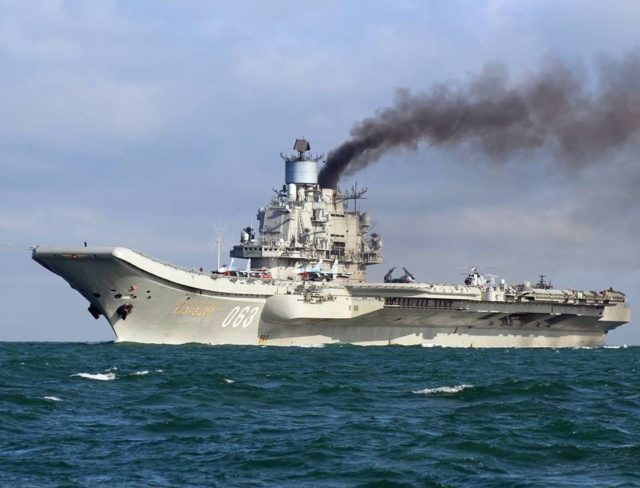
Moscow’s Plans for New Kind of Aircraft Carrier Unlikely to Be Realized
Publication: Eurasia Daily Monitor Volume: 18 Issue: 41
By:

In late February, TASS reported that Russian designers have come up with “a new class of ship.” The vessel, nicknamed the Varan, will function as an aircraft carrier as well as perform other duties, be small enough to not require the renovation of Russian shipyards to build, cost far less than a stand-alone aircraft carrier, and will contribute to the country’s economic recovery. Russian naval officials see this new ship as a replacement for the ill-fated Admiral Kuznetsov carrier (see EDM, May 7, 2018 and June 18, 2019) and as a model for not only the navy of the Russian Federation but of other countries’ as well (TASS, February 25). Moreover, they view the positive comments some Western analysts have made about this project as confirmation of its importance and of what they believe is an indication that Moscow will come out of the pandemic year with a more powerful fleet (Topwar.ru, March 5; Svobodnaya Pressa, March 2).
The widespread enthusiasm, captured in the title of one article, “Russia Is Returning to the Oceans” (Stoletie, March 6), would seem to suggest that President Vladimir Putin’s call, at the end of 2019, for a new Russian carrier to replace the Kuznetsov is on the verge of being realized (Kremlin, December 3, 2019). However—in addition to the obvious fact that the projected new aircraft carrier will be smaller and less capable than its counterparts in other navies—the same problems that have plagued the Kuznetsov remain unresolved. That strongly suggests Moscow is engaging in yet another propaganda bluff rather than announcing something it can achieve, at least anytime soon. Indeed, the problems that the Kuznetsov has faced have been joined by new ones that make the prospects for success on the Varan project far dimmer.
When Putin announced, just before the onset of the COVID-19 pandemic, plans for a new navy with a new carrier, Russian military analysts pointed out several concerns. First, “Russia does not have money even for one aircraft carrier” let alone a new fleet. Second, its naval yards are incapable of building one because of size restrictions. One official mulled the possibility of producing an aircraft carrier in three places and then combining the parts into one ship—but such an enterprise would, by its nature, be riddled with corruption, spiking costs. Third, Moscow desperately needs more smaller ships and especially icebreakers rather than any single large prestige vessel (Nezavisimaya Gazeta, December 2, 2019; The Insider, December 23, 2019; Novaya Gazeta, December 14, 2019). Even worse, some of them wrote, Russian ship designers are so far behind the curve that anything they might propose would be a remake of aging Soviet designs. Two shipyard officials even confirmed that a new carrier might, in fact, simply be built according to specifications drawn up for a Soviet aircraft carrier that was never constructed (TASS, January 12, 2020; Tsenzoru.net, January 14, 2020).
The quite radical Varan proposal—a new class of several ships all built on top of a similar hull (including potentially a carrier, landing helicopter dock, hospital ship and/or Arctic support craft), which the Russian designers are calling a “universal sea complex” (UMK)—is clearly a response to that criticism. Still, any aircraft carrier emerging from it—and estimates are that one will not be built sooner than in ten years—will carry fewer planes and thus be less useful than even the Kuznetsov has been. Despite the enthusiasm now surrounding the idea, it is clear that the Russian shipbuilders and their Kremlin backers have not considered how to overcome not only the old problems but also three new and potentially even larger obstacles that Moscow has no obvious answers for.
First of all, not only have the problems of corruption and confusion in Russia’s shipyards not been overcome, but the yards themselves are facing increasing difficulty in obtaining even basic construction supplies like steel, according to a new report by the East Russia news agency (East Russia, March 5). Consequently, even if the new class of ships is ordered, the most determined Russian yards may not have the raw materials to begin constructing them.
Second, Western sanctions mean that the yards will not be able to source the specialized equipment they need for a modern ship, because they can no longer import them or find analogues produced by Russian firms. The most recent hit Russia has taken in this regard comes from a decision by Norway’s government not to sell Norwegian naval engines to the Russian fleet (Finanz.ru, March 9). Additionally, new Alexei Navalny–related sanctions now going into effect will impose tight controls on the kind of monitoring technologies that the Russian navy, like any modern military, needs to operate (Fontanka, March 5).
And third, even if Russia is able to build the ships, it might not have enough sailors to operate them unless they are automated far more than any Russian vessel up to now. Because of Russia’s demographic decline, which over the past year was greater than at any time in more than a decade, Moscow is now being forced to use military personnel not for their intended mission but to work on economic projects (Kriziz Kopilka, March 6). That makes the impact of sanctions on labor-saving technologies (robotics, sensors, artificial intelligence, etc.) even greater.
This combination of old problems and new ones is already forcing Russia to postpone other key projects, including another Putin-boosted one, “the Polar Trans-Sib” railway (Ritm Eurasia, March 7) just as it did three years ago with its last aircraft carrier project (see EDM, May 7, 2018). Observers now being swept up in the hype about a new kind of Russian capital ship that will supposedly transform naval operations need to remember that when Moscow announces a plan, it does not always have the ability to implement it.



